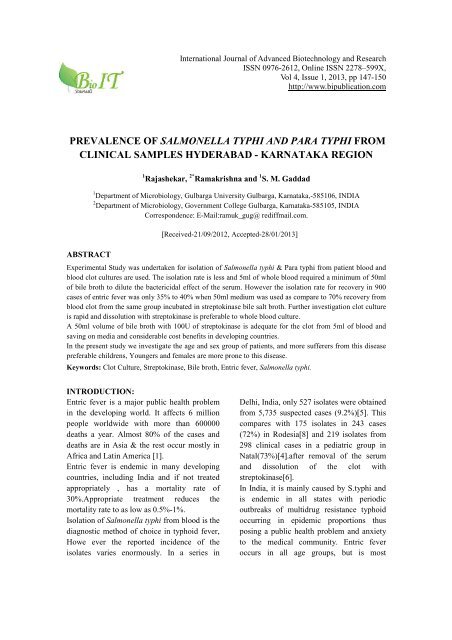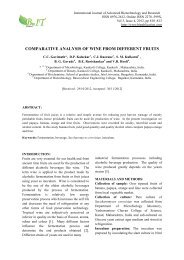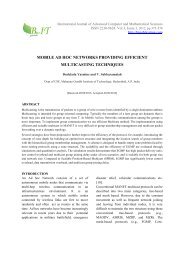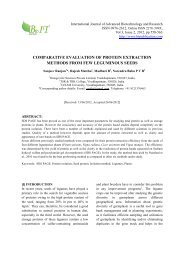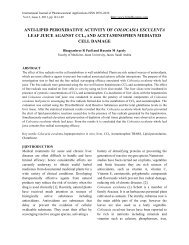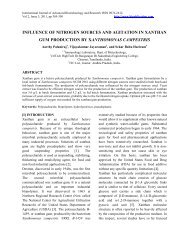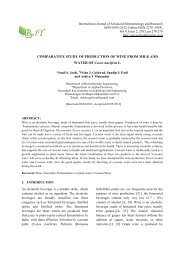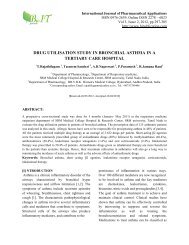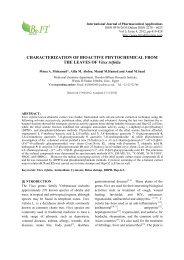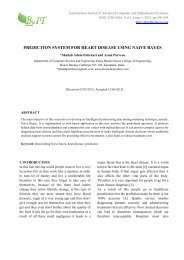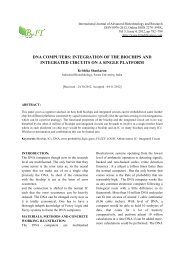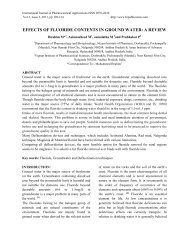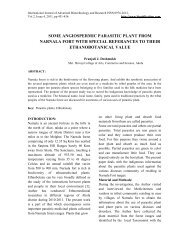prevalence of salmonella typhi and para typhi from clinical samples ...
prevalence of salmonella typhi and para typhi from clinical samples ...
prevalence of salmonella typhi and para typhi from clinical samples ...
Create successful ePaper yourself
Turn your PDF publications into a flip-book with our unique Google optimized e-Paper software.
International Journal <strong>of</strong> Advanced Biotechnology <strong>and</strong> Research<br />
ISSN 0976-2612, Online ISSN 2278–599X,<br />
Vol 4, Issue 1, 2013, pp 147-150<br />
http://www.bipublication.com<br />
PREVALENCE OF SALMONELLA TYPHI AND PARA TYPHI FROM<br />
CLINICAL SAMPLES HYDERABAD - KARNATAKA REGION<br />
ABSTRACT<br />
1 Rajashekar, 2* Ramakrishna <strong>and</strong> 1 S. M. Gaddad<br />
1 Department <strong>of</strong> Microbiology, Gulbarga University Gulbarga, Karnataka,-585106, INDIA<br />
2 Department <strong>of</strong> Microbiology, Government College Gulbarga, Karnataka-585105, INDIA<br />
Correspondence: E-Mail:ramuk_gug@ rediffmail.com.<br />
[Received-21/09/2012, Accepted-28/01/2013]<br />
Experimental Study was undertaken for isolation <strong>of</strong> Salmonella <strong>typhi</strong> & Para <strong>typhi</strong> <strong>from</strong> patient blood <strong>and</strong><br />
blood clot cultures are used. The isolation rate is less <strong>and</strong> 5ml <strong>of</strong> whole blood required a minimum <strong>of</strong> 50ml<br />
<strong>of</strong> bile broth to dilute the bactericidal effect <strong>of</strong> the serum. However the isolation rate for recovery in 900<br />
cases <strong>of</strong> entric fever was only 35% to 40% when 50ml medium was used as compare to 70% recovery <strong>from</strong><br />
blood clot <strong>from</strong> the same group incubated in streptokinase bile salt broth. Further investigation clot culture<br />
is rapid <strong>and</strong> dissolution with streptokinase is preferable to whole blood culture.<br />
A 50ml volume <strong>of</strong> bile broth with 100U <strong>of</strong> streptokinase is adequate for the clot <strong>from</strong> 5ml <strong>of</strong> blood <strong>and</strong><br />
saving on media <strong>and</strong> considerable cost benefits in developing countries.<br />
In the present study we investigate the age <strong>and</strong> sex group <strong>of</strong> patients, <strong>and</strong> more sufferers <strong>from</strong> this disease<br />
preferable childrens, Youngers <strong>and</strong> females are more prone to this disease.<br />
Keywords: Clot Culture, Streptokinase, Bile broth, Entric fever, Salmonella <strong>typhi</strong>.<br />
INTRODUCTION:<br />
Entric fever is a major public health problem<br />
in the developing world. It affects 6 million<br />
people worldwide with more than 600000<br />
deaths a year. Almost 80% <strong>of</strong> the cases <strong>and</strong><br />
deaths are in Asia & the rest occur mostly in<br />
Africa <strong>and</strong> Latin America [1].<br />
Entric fever is endemic in many developing<br />
countries, including India <strong>and</strong> if not treated<br />
appropriately , has a mortality rate <strong>of</strong><br />
30%.Appropriate treatment reduces the<br />
mortality rate to as low as 0.5%-1%.<br />
Isolation <strong>of</strong> Salmonella <strong>typhi</strong> <strong>from</strong> blood is the<br />
diagnostic method <strong>of</strong> choice in typhoid fever,<br />
Howe ever the reported incidence <strong>of</strong> the<br />
isolates varies enormously. In a series in<br />
Delhi, India, only 527 isolates were obtained<br />
<strong>from</strong> 5,735 suspected cases (9.2%)[5]. This<br />
compares with 175 isolates in 243 cases<br />
(72%) in Rodesia[8] <strong>and</strong> 219 isolates <strong>from</strong><br />
298 <strong>clinical</strong> cases in a pediatric group in<br />
Natal(73%)[4].after removal <strong>of</strong> the serum<br />
<strong>and</strong> dissolution <strong>of</strong> the clot with<br />
streptokinase[6].<br />
In India, it is mainly caused by S.<strong>typhi</strong> <strong>and</strong><br />
is endemic in all states with periodic<br />
outbreaks <strong>of</strong> multidrug resistance typhoid<br />
occurring in epidemic proportions thus<br />
posing a public health problem <strong>and</strong> anxiety<br />
to the medical community. Entric fever<br />
occurs in all age groups, but is most
PREVALENCE OF SALMONELLA TYPHI AND PARA TYPHI FROM CLINICAL SAMPLES HYDERABAD<br />
common in children. Since 1972[1], outbreaks<br />
<strong>of</strong> entric fever by resistant plasmid carrying<br />
multidrug resistant strains <strong>of</strong> S.<strong>typhi</strong> have<br />
reported <strong>from</strong> South[2,3]<br />
north[4],east[5],west[6] <strong>and</strong> central[7]India.<br />
MATERIALS AND METHODS:<br />
Collected different <strong>samples</strong> <strong>from</strong> hospitals <strong>and</strong><br />
<strong>clinical</strong> laboratories <strong>of</strong> Gulbarga <strong>and</strong> Raichur<br />
districts weekly twice <strong>from</strong> each lab. The<br />
collected <strong>samples</strong> are further studied for<br />
isolation.<br />
Collected <strong>samples</strong> are further we cultured in<br />
the suitable Brain heart infusion broth culture<br />
media for the growth <strong>and</strong> blood culture bottles<br />
were incubated at 37 o C over night .the<br />
turbidity was observed everyday. If there is<br />
growth subculture was done on next day on<br />
Blood agar <strong>and</strong> Mac Conkey’s agar. After<br />
obtaining good growth, it was plated on<br />
selective medium, Wilson <strong>and</strong> Blair Bismuth<br />
Sulphite agar. Identification <strong>of</strong> the colonies<br />
was made by st<strong>and</strong>ard colonial morphology.<br />
Further we regularly collecting Blood <strong>samples</strong><br />
<strong>and</strong> inoculated into the initial bile broth <strong>and</strong><br />
keep it incubation 18 hrs at 35 o C after<br />
incubation then put on Mac Conkey’s agar<br />
media for overnight incubation non- lactose<br />
fermenting colonies will appear. Further these<br />
colonies are selected for Biochemical test,<br />
IMVIC; Triple Sugar Iron Agar media are<br />
tested as follows for st<strong>and</strong>ard identification<br />
procedures (Cruickshank).The triple sugar iron<br />
slants with a butt were prepared <strong>and</strong> the test<br />
isolates were stabbed in the butt <strong>and</strong> streaked<br />
over the slants. The tubes were incubated at<br />
37 o C for 24 hours. The crescent shape<br />
blackening <strong>of</strong> the medium indicates the<br />
formation <strong>of</strong> H2S, which was recorded as<br />
positive <strong>and</strong> further we carried out Citrate<br />
utilization, Oxidase test has done.<br />
Serotyping <strong>of</strong> confirmed isolates <strong>of</strong><br />
Salmonella <strong>typhi</strong> were carried out by slide<br />
agglutination test. This procedure prescribed<br />
by Cruckshanak. 1975, was followed for all<br />
the isolates <strong>of</strong> Salmonella <strong>typhi</strong> against<br />
polyvalent-O, polyvalent-H, d-H(S, <strong>typhi</strong> H)<br />
<strong>and</strong> Vi-antisera.<br />
RESULTS:<br />
Total period <strong>of</strong> two year, initially screened<br />
with different diagnostic lab <strong>samples</strong> like<br />
faeces, urine, CSF <strong>and</strong> Blood <strong>samples</strong><br />
collected <strong>and</strong> highest <strong>salmonella</strong> strains<br />
isolated <strong>from</strong> blood <strong>samples</strong>. From faeces,<br />
urine, <strong>and</strong> CSF. Isolation rate is very less so,<br />
finally we selected blood sample <strong>and</strong><br />
regularly we collected blood <strong>samples</strong> <strong>from</strong><br />
different diagnostic laboratories patients <strong>of</strong><br />
Gulbarga <strong>and</strong> Raichur districts.<br />
It was observed that a large number<br />
<strong>salmonella</strong> cases in the summer months like<br />
April, May <strong>and</strong> June than monsoon season.<br />
The number cases decreases during winter.<br />
During summer <strong>and</strong> monsoon months the<br />
water supply <strong>and</strong> sanitation systems are not<br />
in proper utilization <strong>and</strong> maintains in these<br />
districts, because very high (extreme)<br />
temperature compare to all other parts <strong>of</strong> the<br />
Karnataka state, which could account for the<br />
higher incidence in these months<br />
(Fig.1).April-June, July-Sept, Oct-Dec, Jan-<br />
Mar.<br />
Seasonal distributuion <strong>of</strong> cases <strong>of</strong><br />
Entric fever<br />
(Figure 1): 1-April-june, 2-july-sept, 3-Oct-Dec,<br />
4-Jan-Mar.<br />
Ramakrishna, et al. 148<br />
Percentag e <strong>of</strong> cases<br />
50<br />
40<br />
30<br />
20<br />
10<br />
0<br />
1 2 3 4<br />
seasons
PREVALENCE OF SALMONELLA TYPHI AND PARA TYPHI FROM CLINICAL SAMPLES HYDERABAD<br />
Figure 2<br />
Table 1. Age <strong>and</strong> sex distribution <strong>of</strong> patients<br />
suffering <strong>from</strong> Entric fever<br />
Age Male Female<br />
Neonates(0-28<br />
days)<br />
Pediatrics(1-10) 91 62<br />
Teenage(11-20) 100 153<br />
Adults(21-30) 146 174<br />
Middle age(31-<br />
40)<br />
Late middle(41-<br />
50)<br />
Old age(50<br />
onwards)<br />
Total<br />
(%)<br />
Percentage<br />
(%)<br />
0 1 1 0.1<br />
39 25<br />
153<br />
253<br />
320<br />
64<br />
17<br />
28.1<br />
35.5<br />
7.1<br />
18 21 39 4.3<br />
29 36 65 7.2<br />
A total <strong>of</strong> one year study 905 patients enter in<br />
this study, <strong>of</strong> which 423 <strong>of</strong> male <strong>and</strong> 472<br />
female in all had bacteraemia due to<br />
Salmonella spp.. the majority <strong>of</strong> isolates,153<br />
(17% )were found pediatrics, 253(28.1% ) are<br />
<strong>from</strong> children <strong>and</strong> 320(35.5% ) isolated <strong>from</strong><br />
adults Shown ( Table 1).the case were<br />
predominately in the 1-10 year <strong>of</strong> the age<br />
group, 11-20 year teenage group <strong>and</strong> 21-30<br />
year <strong>of</strong> the age group adults were more suffer<br />
than middle age, late middle age <strong>and</strong> old age<br />
people. This is one <strong>of</strong> the very important<br />
reports in this region.<br />
DISCUSSION:<br />
Entric fever is a major public health problem<br />
in our country. Proper sanitation, public<br />
health education & vaccination are long<br />
term preventive measures that would<br />
improve this satiation.<br />
The com<strong>para</strong>tive results that 50ml <strong>of</strong><br />
medium with 5ml <strong>of</strong> blood is inadequate for<br />
whole blood cultures. Our further<br />
investigations have shown that somewhere<br />
in excess <strong>of</strong> 100ml <strong>and</strong> preferable nearer to<br />
200ml <strong>of</strong> medium is needed for 5ml <strong>of</strong> blood<br />
if com<strong>para</strong>ble isolation rates are to be<br />
obtained for blood clot <strong>and</strong> whole blood<br />
cultures. In a series <strong>of</strong> studies 100, 150, <strong>and</strong><br />
200ml <strong>of</strong> medium for 5ml <strong>of</strong> blood for<br />
whole blood cultures, the isolation rates<br />
compared to those <strong>from</strong> blood clot were 80,<br />
90&100 respectively. Isolaton <strong>from</strong> blood<br />
colt is for more reliable, provided rapid lysis<br />
occurs, since organisms trapped within the<br />
clot are susceptible to serum factors<br />
adsorbed to the fibrin meshwork<br />
(K.C.watson M.B thesis). We have utilized<br />
the method <strong>of</strong> lysis with streptokinase in bile<br />
salt broth in a series <strong>of</strong> almost 1200 cases <strong>of</strong><br />
entric fever over a period <strong>of</strong> 2 years <strong>and</strong><br />
have impressed by the high isolation rate.<br />
Totally 1200 patients entered the study <strong>of</strong><br />
which male <strong>and</strong> females all <strong>of</strong> them had<br />
bacteremia due to the Salmonella Spp.. The<br />
majority <strong>of</strong> the 17% pediatrics, 29%<br />
childrens, 36% adults <strong>of</strong> these three groups<br />
are more sufferer than other groups.<br />
In this study adults are more suffering <strong>from</strong><br />
this disease because they are more exposed<br />
in the outside food habits <strong>and</strong> water. This<br />
report is very important in this region. One<br />
more observation in this present study,<br />
different seasons we collected <strong>samples</strong> <strong>and</strong><br />
Ramakrishna, et al. 149
PREVALENCE OF SALMONELLA TYPHI AND PARA TYPHI FROM CLINICAL SAMPLES HYDERABAD<br />
this disease is more occurs especially as per<br />
our studies in the month <strong>of</strong> April-June, these<br />
months are very hot <strong>and</strong> dry seasons <strong>and</strong> july-<br />
Sept mansoon are more people are suffering<br />
<strong>from</strong> this infection. It was observed that large<br />
number <strong>of</strong> typhoid cases decreases during<br />
winter than summer <strong>and</strong> mansoon months the<br />
water is contaminated due to pollutants <strong>and</strong><br />
proper sanitation systems are not is properly<br />
utilization <strong>and</strong> maintance.<br />
In these districts temperature is very high<br />
(extreme) so, it is also one important factor to<br />
higher incidence in these months.<br />
REFERENCE:<br />
1. The World health report, report <strong>of</strong> the<br />
direct general WHO, world health<br />
Organization: Geneva: 1996.<br />
2. Sen, R., <strong>and</strong> S.N.Saxena,.typhoid fever in<br />
Delhi area : an assessment based on<br />
bacteriological <strong>and</strong> some epidemiological<br />
findings, J.Indian Med.Assoc. 1968, 50:<br />
297-304.<br />
3. Wicks, A.C., G.S Holmes, <strong>and</strong><br />
L.Davidson, Endemic typhoid fever. A<br />
diagnostic pitfall.Q.J. med. 1971, 40:<br />
341-354.<br />
4. Seragg, J., C Rubidge, <strong>and</strong> H.L.,<br />
Wallace,.Typhoid fever in African <strong>and</strong><br />
Indian children in Durban. Arch.Dis.child.<br />
1969, 44:18-28.<br />
5. Watson, K.C.clot culture in typhoid fever.<br />
J.clin.Pathol. 1954, 7:305-307.<br />
6. Ackers, M.L., M.D, Tauve, R.V.<strong>and</strong><br />
Mintz. Laboratory based surveillance <strong>of</strong><br />
Salmonella serotype <strong>typhi</strong> infections in the<br />
United States: antimicrobial resistance<br />
on the rise.JAMA, 2000, 283, 2668-<br />
2673.<br />
7. Bauver, A.W, Kirby W.M.M., Sherries,<br />
J.C <strong>and</strong> Truck, M. Antibiotic<br />
Susceptibility testing by st<strong>and</strong>ardized<br />
single disc method.Am.J.Clin.Pathol<br />
1996, 45,493-496.<br />
8. Giraj,A,M., seetha,K.S., Gopalkrishna,<br />
B.K., <strong>and</strong> Shivavn<strong>and</strong>a, P.G, Drug<br />
resistance pattern & phage types <strong>of</strong><br />
Salmonella <strong>typhi</strong> isolates in<br />
Manipal,south Karnataka. Indian<br />
J.Med.Sci 5 .1999, 3,486-489.<br />
9. Edelmann, R<strong>and</strong> Levine, M.M.Summary<br />
<strong>of</strong> an international workshop on typhoid<br />
fever.Rev Infect Dis. 1986, 8,329-349.<br />
10. Gaind,R.,Paglietti, B., Murgia,M.,<br />
Dawar,R., Uzzau,S., Cappuccinelli,P.,<br />
Deb,M., Aggarwal,p <strong>and</strong><br />
Rubino,S..Molecular characterization <strong>of</strong><br />
cipr<strong>of</strong>loxacin resistant Salmonella<br />
entarica serovar Typhi <strong>and</strong> Para<strong>typhi</strong> A<br />
causing entric fever in India.J<br />
Antimicrob. Chemother.2006. 58, 1139-<br />
1144.<br />
11. Gupta, A.Multidrug resistant typhoid<br />
fever in children: epidemiology <strong>and</strong><br />
therapeutic approach.Pediatr.Infect. Dis<br />
J. 1994.13, 134-140.<br />
12. Harish, B.N., Madhulika, U <strong>and</strong> Parija,<br />
S.C.,.Isolates high level cipr<strong>of</strong>loxacin<br />
resistance in Salmonella entrica Sub<br />
spp.. Entrica serotype Para<strong>typhi</strong> A.<br />
J.Med.Micxrobiol.53, 2004,819.<br />
Ramakrishna, et al. 150


